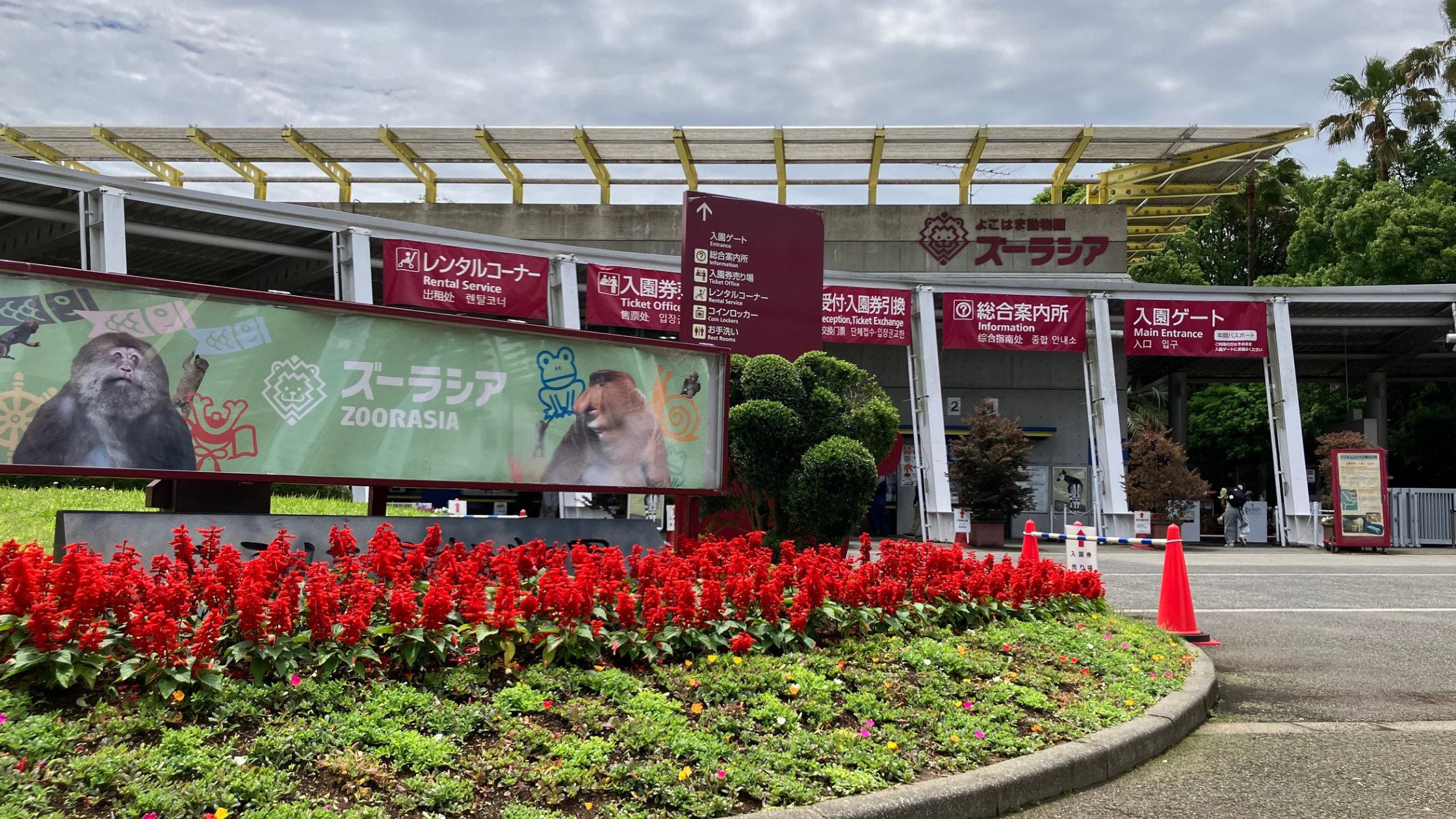
Zoorasia (Yokohama Zoological Gardens) is a must-see attraction for visitors to Yokohama. Opened in 1999 in the city’s Asahi Ward, it is one of Japan’s largest and most innovative zoos. Travel writers praise Zoorasia’s open design and natural habitats, noting that it is one of Japan’s biggest and best zoos. Unlike traditional zoo cages, Zoorasia uses very few fences: animals roam in spacious, ecosystem-style exhibits that closely mimic their wild homes. This unique approach makes Zoorasia stand out among zoos in Asia and earns it high marks as a family-friendly attraction in Yokohama. The park’s theme of “harmony with nature” comes alive in each zone, and you’ll often feel like you’re on a walking safari as you explore lush forests, grasslands and wetlands.
Immersive Themed Habitats
Zoorasia is laid out in themed ecological zones, each recreating a different climate and environment. Visitors follow wide, stroller-friendly paths past winding streams and dense plantings, with many exhibits viewed through glass for up-close encounters. Key habitat zones include:
- Asian Tropical Forest: Home to endangered Sumatran tigers, Malayan tapirs, orangutans and other Asian species. This lush jungle area feels very humid and green.
- Subarctic Forest: A cool, boreal zone where polar bears, seals, and penguins live among spruce and birch trees. You can often watch polar bears swimming or seals basking by panoramic viewing windows.
- Oceanian Grassland: Wide, open fields for Australian and Pacific animals like red kangaroos, emus and tree kangaroos. You may see kangaroos grazing or emus roaming almost freely.
- Central Asian Highland: Rocky terrain for Central Asian monkeys and other mountain species.
- Japanese Countryside (Satoyama): A recreated rural Japan with local wildlife. Wild tanuki (Japanese raccoon dogs), foxes, Japanese macaques and even Japanese black bears are kept in spacious woodland enclosures.
- Amazon Jungle: Dense tropical rainforest habitat for South American creatures. Capybaras, ocelots, monkeys and giant anteaters can be seen in this humid, jungle-like zone.
- African Tropical Rainforest: Shady jungle for African species like okapi, chimpanzees and various antelope. (You’ll recognize the okapi by its zebra-striped legs and horse-like face!)
- African Savanna: Grassy plains with giraffes, zebras, lions, eland, wildebeest and a southern white rhinoceros. This is one of the most popular areas – you can walk under an elevated boardwalk for a wide view of the lion and giraffe habitats.
Each zone flows naturally into the next, and signage is in English and Japanese, with friendly animal facts. Unlike many zoos, Zoorasia keeps visible barriers to a minimum so visitors feel immersed in the landscape. There’s even a grass park and a large children’s playground (Wanpaku Forest) set within the zoo grounds, giving kids a place to burn off energy between exhibits. The zoo also includes the Yokohama City Breeding Center, a behind-the-scenes research facility focused on preserving rare species.
Rare Species and Interactive Fun
Zoorasia is noted for its collection of rare and exotic animals. In addition to common favorites, you’ll spot species that are unusual for Japan. For example, the Asian tropical area features Sumatran tigers and Malayan tapirs – both endangered in the wild. The African areas showcase okapi (a giraffe relative with zebra-like stripes) and proboscis monkeys. In the Subarctic Forest you can watch polar bears on display, as well as spectacled bears and small-mammal species. Overall, a rich diversity of rare animals is a highlight of Zoorasia.
Zoorasia goes beyond static exhibits. It offers interactive experiences and educational shows that are fun for all ages. Children can visit the Animal Meeting Plaza, a petting area where they can feed and touch friendly farm animals and small mammals. There are scheduled feeding and petting sessions (check the daily schedule on arrival) and even a bird show in the African Savannah zone. Special events and a petting zoo add to the fun and learning experience. Throughout the park, interpretive signs and occasional zookeeper talks teach visitors about conservation and each animal’s natural lifestyle. Everything here is designed for immersion: you may walk through aviaries or descend a boardwalk under a chimpanzee climbway, truly feeling part of the animals’ environment.
Family-Friendly Attractions and Amenities
Zoorasia is very popular with families – and it’s easy to see why. Wide, stroller-friendly paths wind through shaded forests and open fields, so even on busy days it never feels claustrophobic. There are dozens of benches, picnic tables and rest areas in the park, allowing families to rest or enjoy a packed lunch at leisure. Several playgrounds and hands-on areas (including the aforementioned Wanpaku Forest) keep young children entertained between animal stops. Reviewers especially note that it is a great place to spend a relaxing and educational day with family, thanks to the clean, accessible design.
To make visits smoother, Zoorasia offers many conveniences for families: stroller and wheelchair rentals are available, and barrier-free ramps connect the paths. Baby changing and nursing rooms are scattered around the zoo, and even family restrooms feature baby seats. For a quick meal or snack, you’ll find several restaurants and cafes on-site, including a grill that sells burgers unique to the zoo, as well as vending machines and an ice-cream stand. Pamphlets and signage are provided in English, Chinese and Korean, and many staff speak basic English, making it easy for international visitors. With all these features, Zoorasia frequently tops lists of family-friendly attractions in Yokohama and is counted among Asia’s most engaging zoological parks.
Visiting Tips and Practical Info
- Getting There: Zoorasia is located at 1175-1 Kamishirane-cho, Asahi Ward, about 10–12 km north of central Yokohama. From Yokohama Station, take the Sotetsu Line to Tsurugamine Station (about 14 minutes), then catch the Keikyu Bus bound for Zoorasia (20 minutes). Alternatively, take the JR Yokohama Line or Yokohama Subway to Nakayama Station and board the Zoorasia-bound bus (10 minutes ride). There is ample paid parking if you drive.
- Hours & Admission: The zoo is open daily from 9:30 AM to 4:30 PM (last entry 4:00 PM). It is closed on Tuesdays (except when Tuesday is a national holiday) and also from Dec 29 to Jan 1. Adult tickets (ages 18+) are ¥800, high school students ¥300, and elementary/junior-high ¥200; preschoolers enter free.
- Facilities: Restrooms (including diaper-changing stations), coin lockers and drinking fountains are available throughout the park. Nursing rooms are provided for infants. If you prefer not to walk the entire route, a small zoo shuttle bus runs through the grounds (¥200, or ¥400 for an all-day pass).
- Plan Your Visit: The park is very large – a loop around the whole zoo can take 3–4 hours or more to complete at a leisurely pace. Wear comfortable shoes and allow plenty of time to explore. You can easily stop for breaks, eat a picnic, and return to any favorite exhibits as needed.
Overall, Zoorasia is thoughtfully laid-out and easy for international families to navigate. Helpful staff, multilingual signage, and kid-centric amenities mean that even travelers unfamiliar with Japan will feel welcome. Many online guides list Zoorasia under “things to do in Yokohama” for families and animal lovers alike.
Conclusion: A Must-Visit Yokohama Zoo
Zoorasia Yokohama truly delivers on its promise of an immersive zoo experience. Its innovative design and focus on animal welfare make it stand out as a top attraction – in fact, one guide calls it one of Japan’s biggest and best zoos. Whether you’re watching giraffes under the setting sun or feeding goats at the Animal Plaza, the combination of rare animals, natural settings and family-friendly fun ensures a memorable day for all ages. For anyone planning a trip to Yokohama, adding Zoorasia to your itinerary means enjoying one of Japan’s premier wildlife parks. It’s truly one of the best zoos in Japan, and a unique wildlife adventure in Asia that the whole family will cherish.

